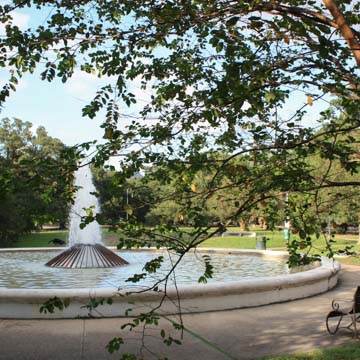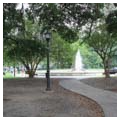This elongated, grassy public space, part of Lafon’s ambitious urban plan for the area, flowered as a fashionable address in the 1840s and 1850s, and many fine mid- to-late-nineteenth-century houses still surround the square. Especially notable are the Rodewald-King House (1749 Coliseum Street), built in 1849 for banker Frederick Rodewald and purchased by novelist Grace King in 1904, which has a two-story Greek Revival gallery and an Italianate segmental-arched entrance door; the Greek Revival three-story house with a two-story gallery at 1228 Race Street, designed in 1861 by Henry Howard and constructed in 1867 by builder Frederick Wing after the Civil War for wholesale grocer John T. Moore; and the E. T. Robinson House (1456 Camp Street), a two-story, side-hall town house of stuccoed brick, perhaps built by architect Thomas K. Wharton in 1859 (he lived in this neighborhood while supervising construction of the Custom House [OR80]).
The renovation of Coliseum Square in the mid-1970s reinforced (and rewarded) efforts by a handful of preservationists who had recently bought dilapidated nineteenth-century houses, rehabilitating them in efforts to preserve the historic architectural urban fabric as well as to voice opposition to the location here of the second span of the Mississippi River bridge, which likely would have destroyed the neighborhood. The park’s design replicates pedestrian patterns from a late-nineteenth-century design, featuring a water basin with fountain and incorporating green “fingers” that extend from the “square” in three directions. Fears that architectural renovations of the 1970s and 1980s would diminish the neighborhood’s unique character have proved unfounded.


















